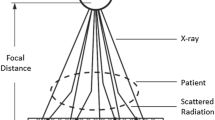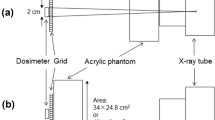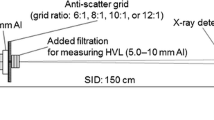Abstract
In clinical X-ray imaging, a focused grid is used to enhance image contrast by removing scattered radiation. The focused grid removes scattered radiation only when the X-ray source is located in the focal point of the grid. In oblique imaging, the grid cuts off some of the primary radiation because the X-ray radiation is not aligned with the lead strips. If the tilting angle of the grid elements and the direction of X-ray radiation are not aligned, it results in less X-ray reaching the imaging detector. Therefore, in oblique imaging cases, the exposure condition is generally increased to obtain a clinically valuable image. In this paper, we propose a method to acquire proper image quality in terms of both contrast and signal-to-noise ratio (SNR) in oblique X-ray imaging by positioning the subject in a specific grid region where the X-ray projection is aligned with the tilted angle of the grid lead strips. We examined experimental imaging with several types of radiographic phantoms, and the results demonstrate the feasibility of the proposed method. This study is applicable to non-standard X-ray imaging cases involving patients who are difficult to position correctly in oblique views. In such cases, the proposed approach sets the direction of X-ray radiation without requiring patient movement.












Similar content being viewed by others
Data availability
Data sharing not applicable to this article as no datasets were generated or analyzed during the current study.
References
Targett H, Hutchinson D, Hartley R, McWilliam R, Lopez B, Crone B, Bonner S (2023) Enhanced visualization of mobile chest X-ray images in the intensive care setting using software scatter correction. Acta Radiol. https://doi.org/10.1177/02841851221087631
Nakano T (2018) Improvement of the radiographic contrast in off-center radiography with focused grid. Nihon Hoshasen Gijutsu Gakkai Zasshi. https://doi.org/10.6009/jjrt.2018_jsrt_74.12.1412
Miller CP, Sabino J, Bible JE, Whang PG, Grauer JN (2011) Oblique radiographs compared favorably with computed tomography images in assessing cervical foraminal area. Am J Orthop 40(5):241–245
Hammouri QM, Simpson AK, Grauer JN, Rechtine G (2007) From the imaging department: a questionnaire study of the use of radiographs in the evaluation of spine complaints. Spine J. https://doi.org/10.1016/j.spinee.2007.04.015
Lampignano J, Kendrick LE (2020) Bontrager's Textbook of Radiographic Positioning and Related Anatomy. 10th ed. Elsevier
Murphy A (2023) Cervical spine AP oblique view. Radiopaedia. https://radiopaedia.org/articles/cervical-spine-ap-oblique-view
Christensen EE, Bull KW, Dowdey JE (1974) Grid cutoff with oblique radiographic techniques. Radiology. https://doi.org/10.1148/111.2.473
Sandborg M, Dance DR, Alm CG, Persliden J (1993) The choice of anti-scatter grids in diagnostic radiology: the optimization of image quality and absorbed dose. Linköping University Electronic Press
Fetterly KA, Schueler BA (2007) Experimental evaluation of fiber-interspaced antiscatter grids for large patient imaging with digital x-ray systems. Phys Med Biol. https://doi.org/10.1088/0031-9155/52/16/010
Fritz S, Jones AK (2014) Guidelines for anti-scatter grid use in pediatric digital radiography. Pediatr Radiol. https://doi.org/10.1007/s00247-013-2824-9
Sayed M, Knapp KM, Fulford J, Heales C, Alqahtani SJ (2023) The principles and effectiveness of X-ray scatter correction software for diagnostic X-ray imaging: A scoping review. Eur J Radiol. https://doi.org/10.1016/j.ejrad.2022.110600
Tafti A, Byerly DW (2022) X-ray Radiographic Patient Positioning. StatPearls Publishing, In StatPearls
Tugwell-Allsup J, England A, Hogg P, Legg JS (2017) Challenges Associated With X-ray Imaging of Stretcher-Bound Patients. Radiol Technol 89(2):159–172
Lee C, Porter K (2007) The prehospital management of pelvic fractures. Emerg Med J. https://doi.org/10.1136%2Femj.2006.041384
Beebe R, Myers J (2012) chapter 4 Spinal trauma. In: Professional Paramedic: Trauma Care and EMS Operations, Vol 3. New York, NY: Cengage Learning
Carlton R, Adler A (2013) Principles of Radiographic Imaging: An Art and a Science, 5th edn. Cengage Learning, Clifton Park, NY
Moore C, Wood T, Avery G, Balcam S, Needler L, Smith A, Saunderson J, Beavis A (2015) Investigating the use of an antiscatter grid in chest radiography for average adults with a computed radiography imaging system. Br J Radiol. https://doi.org/10.1259/bjr.20140613
Lin Z, Plut LF, Cooper VN (1999) Grids and digital grids: the improvement of contrast and SNR in digital radiography. Med Imaging. https://doi.org/10.1117/12.349538
Dick CE, Motz JW (1978) New method for the experimental evaluation of x-ray grids. Med Phys. https://doi.org/10.1118/1.594406
Lee S, Chung W (2019) Quantitative analysis of effects of the grid specifications on the quality of digital radiography images. Australas Phys Eng Sci Med. https://doi.org/10.1007/s13246-019-00756-3
Court L, Yamazaki T (2004) Technical note: a comparison of antiscatter grids for digital radiography. Br J Radiol. https://doi.org/10.1259/bjr/21117919
Boldingh WH (1964) Grids to reduce scattered X-rays in medical radiography. PhD Thesis, Eindhoven University of Technology
Van Metter RL, Trauernicht DP, Steklenski DJ (1993) Medical Imaging 1993: Physics of Medical Imaging. https://doi.org/10.1117/12.154600
Tang CM, Stier E, Fischer K, Guckel H (1998) Anti-scattering X-ray grid. Microsystem Technol Med Phys. https://doi.org/10.1007/S005420050128
Zhou A, Tan Q, White L, Davidson R (2020) New antiscatter grid design by optimization of strip thickness and height. Int J Imaging Sys Technol. https://doi.org/10.1002/ima.22521
Rastegar A, Beigi J, Saeidi E et al (2019) Reject analysis in digital radiography: a local study on radiographers and students’ attitude in Iran. Med J Islam Repub Iran. https://doi.org/10.34171/mjiri.33.49
Acknowledgments
This work was supported by the Konyang university research fund in 2023.
Author information
Authors and Affiliations
Corresponding author
Ethics declarations
Conflict of interests
The authors declare that they have no known competing financial interests or personal relationships that could have appeared to influence the work reported in this paper.
Additional information
Publisher's Note
Springer Nature remains neutral with regard to jurisdictional claims in published maps and institutional affiliations.
It has not been published elsewhere and that it has not been submitted simultaneously for publication elsewhere.
Rights and permissions
Springer Nature or its licensor (e.g. a society or other partner) holds exclusive rights to this article under a publishing agreement with the author(s) or other rightsholder(s); author self-archiving of the accepted manuscript version of this article is solely governed by the terms of such publishing agreement and applicable law.
About this article
Cite this article
Kim, Y.B., Kim, GH. & Kim, YG. A preliminary study for image degradation by grid cutoff and radiation scattering in oblique X-ray imaging. Multimed Tools Appl (2024). https://doi.org/10.1007/s11042-024-19125-8
Received:
Revised:
Accepted:
Published:
DOI: https://doi.org/10.1007/s11042-024-19125-8




